11 April 2007
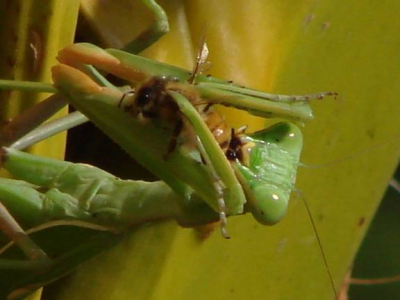
A giant preying mantis predating on a bee
Photo by Aymen Ibrahem, Senior Astronomy Specialist
The preying mantis is a predatory insect, preying mainly on other insects. It can even eat small birds, e.g., the humming bird, as prey. On 23 December 2006, Mr. Aymen Ibrahem, Senior Astronomy Specialist, pictured a giant preying mantis predating on a bee. Ibrahem took numerous fascinating photos of this breathtaking scene, showing the ferocious predator eating the doomed bee to the last shard.
The praying mantis is characterized by its modified forelegs that act as raptorial arms with spikes for grabbing and holding the prey. This insect is named for its characteristic prayer-like stance. In the insect world, the praying mantis is a fearsome, top predator; bats, and some birds prey on it. Also, some spiders and snakes attack the praying mantis.
Ibrahem was practicing his favorite hobby of wildlife photography in a park in Alexandria. He often photographs birds, butterflies, bees, wasps, hoverflies and other insects in Egypt. He uses a variety of cameras, telephotos and macro lenses.
Ibrahem wrote the following account of his interesting observation.
A Praying Mantis devours a Bee
By Aymen Ibrahem
On Saturday, 23 December 2006, I visited a park in Alexandria. I enjoyed photographing a Small White butterfly and numerous bees, wasps, bugs and hoverflies.
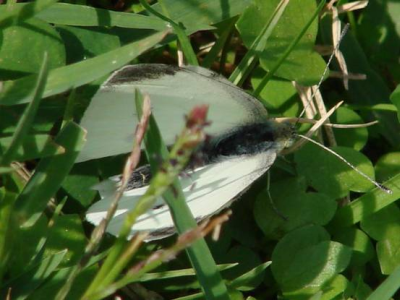
Fig (1)
A Small White Butterfly
Photo by Aymen Ibrahem, Senior Astronomy Specialist
I also noticed that there were swarms of bees, inhabiting several beehives, built in palm trees. I photographed these beehives, recording the interesting behavior of the energetic insects.
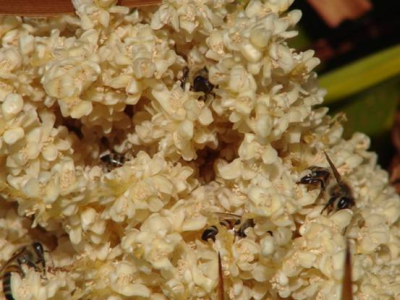
Fig (2)
A Beehive
Photo by Aymen Ibrahem, Senior Astronomy Specialist
Inspecting the trees for more insects to observe, I spotted a giant praying mantis, lurking amid the leaves of a short palm tree in ambush hunting. It was about 15 cm in length. It was also highly camouflaged. Its color matched almost exactly that of the leaves. That was a breathtaking sight!
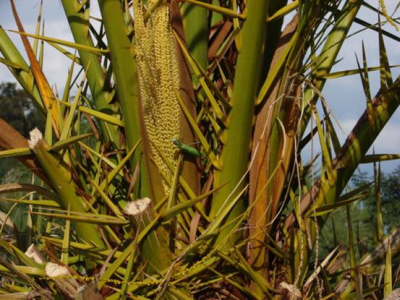
Fig (3)
Lurking Monster
A camouflaged praying mantis is lying amid the leaves of a short palm tree.
Photo by Aymen Ibrahem, Senior Astronomy Specialist
I took numerous photos of the mantis with different zoom levels. The mantis seemed to be cleaning its forelegs in preparation for catching a prey!
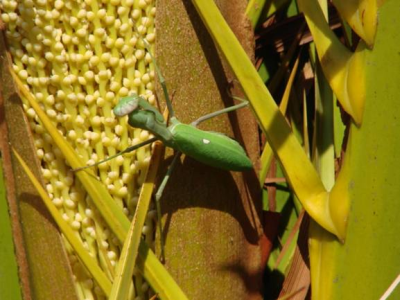
Fig (4)
Praying Mantis Close-up
Photo by Aymen Ibrahem, Senior Astronomy Specialist
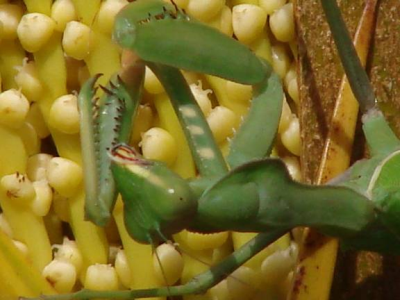
Fig (5)
The praying mantis was cleaning its raptorial legs, in preparation for catching a prey.
Photo by Aymen Ibrahem, Senior Astronomy Specialist
Then, I saw a bee flying near the mantis. I expected the mantis would catch it. When the bee came within the powerful grasp of the mantis's raptorial legs, the formidable predator captured the bee, and began to eat it.
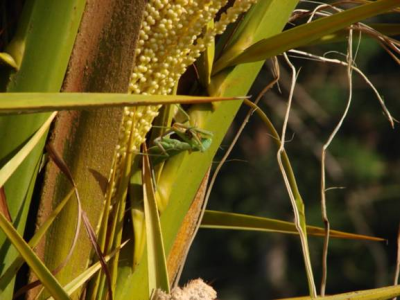
Fig (6)
Capture
The mantis captures the bee.
The photo was taken immediately after the mantis captured the bee.
Photo by Aymen Ibrahem, Senior Astronomy Specialist
With a great thrill, I immediately began to record the behavior of the predator and its prey. I took numerous photos, in different zoom levels, showing the mantis devouring the bee to the last shard of its soft, small body. That was somewhat brief, lasting about 7 minutes. I believe the six-legged beast was very hungry! Also, the bee was motionless. It showed no resistance.
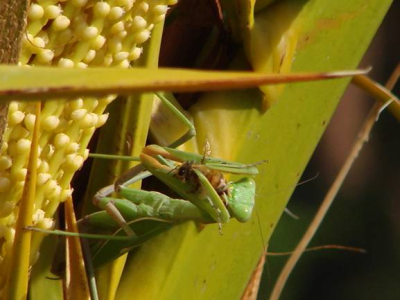
Fig (7)
Close-up
Photo by Aymen Ibrahem, Senior Astronomy Specialist
Heavy rain fell shortly afterwards, but the mantis withstood the rains, probably trying to catch more preys. In the picture gallery below, I present more photos demonstrating the sequence of predation.
Picture Gallery
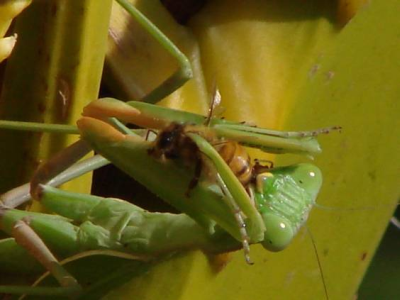
Fig (8)
A Hopeless Prey
Photo by Aymen Ibrahem, Senior Astronomy Specialist
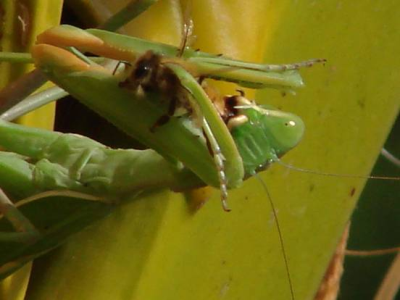
Fig (9)
Bit by Bit
The mantis grasps the paralyzed prey, and consumes it gradually.
Photo by Aymen Ibrahem, Senior Astronomy Specialist
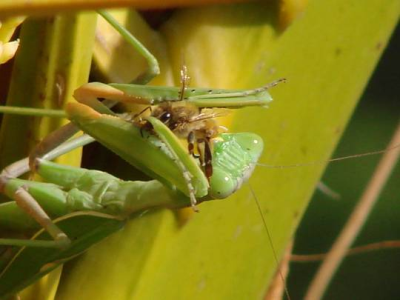
Fig (10)
Fork and Knife
The clever hunter enjoys a good meal!
Photo by Aymen Ibrahem, Senior Astronomy Specialist

Fig (11)
A Delicious Wing
The fierce predator even eats the wings of the bee.
Photo by Aymen Ibrahem, Senior Astronomy Specialist
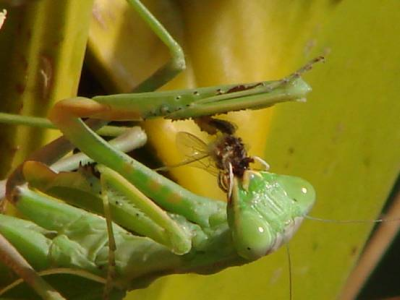
Fig (12)
Nearing to finish!
Photo by Aymen Ibrahem, Senior Astronomy Specialist
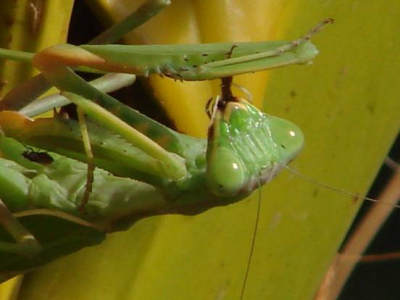
Fig (13)
The Last Shard
A small fly is visible on the mantis arm. It was probably trying to scavenge the bee.
Photo by Aymen Ibrahem, Senior Astronomy Specialist
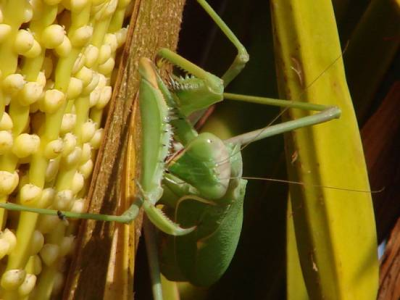
Fig (14)
Cleaning the Raptorial Legs
Having consumed the bee entirely, the mantis cleans its raptorial legs.
Photo by Aymen Ibrahem, Senior Astronomy Specialist
Aymen Mohamed Ibrahem
Senior Astronomy Specialist